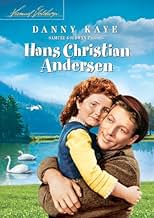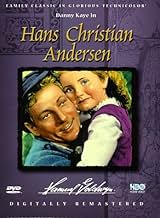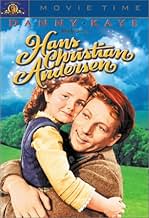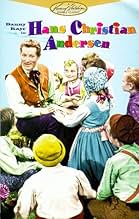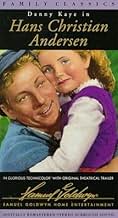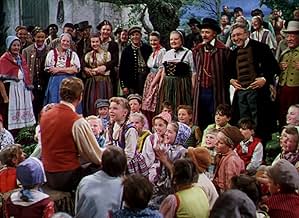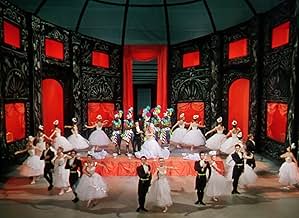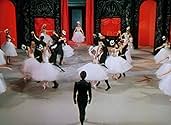IMDb RATING
6.8/10
4.4K
YOUR RATING
The opening scene of the movie describes it best: "Once upon a time there lived in Denmark a great storyteller named Hans Christian Andersen. This is not the story of his life, but a fairy t... Read allThe opening scene of the movie describes it best: "Once upon a time there lived in Denmark a great storyteller named Hans Christian Andersen. This is not the story of his life, but a fairy tale about the great spinner of fairy tales."The opening scene of the movie describes it best: "Once upon a time there lived in Denmark a great storyteller named Hans Christian Andersen. This is not the story of his life, but a fairy tale about the great spinner of fairy tales."
- Nominated for 6 Oscars
- 10 nominations total
Zizi Jeanmaire
- Doro
- (as Jeanmaire The Famous French Ballerina)
Joseph Walsh
- Peter
- (as Joey Walsh)
Peter J. Votrian
- Lars
- (as Peter Votrian)
Lee Aaker
- Little Boy
- (uncredited)
Patsy Bangs
- Dancer
- (uncredited)
Arthur Berkeley
- Townsman
- (uncredited)
Storyline
Did you know
- TriviaIn order to cover the necessary camera tricks, and to add "magic" to the Little Mermaid ballet, it was decided that, rather than presenting it as an actual ballet, they would have Hans imagine how it would look. This allowed them to do things on the screen which would be impossible on the stage.
- GoofsDuring the "Wonderful, Wonderful Copenhagen" song the concertina player directly behind the singer never moves his fingers on the keys.
- Crazy creditsOpening credits: "Once upon a time there lived in Denmark a great storyteller named Hans Christian Andersen. This is not the story of his life, but a fairy tale about this great spinner of fairy tales."
- ConnectionsFeatured in Siskel & Ebert: The Movies We Loved as Kids (1991)
- SoundtracksThe King's New Clothes
(uncredited)
Music and Lyrics by Frank Loesser
Sung by Danny Kaye and children
Reprised by Kaye, children, and Chorus in the Finale
Featured review
Every single biopic of a creative artist tells the same story, whether it's true or not: the Philistine World, or some part thereof, rejects the artist, and fails to see his greatness; but later on, perhaps during his lifetime, perhaps not, it sees the error of its ways. That happens here. Hans Christian Andersen is a village cobbler whose compulsive inventiveness is little thought of until he makes good in Copenhagen, after which...
But there's much more going on.
There's no doubt that Andersen was a great artist, in some sense. `The Ugly Duckling' and `The Emperor's New Clothes' are two of the greatest short stories - fables, folktales - all of these - ever composed. But he had his limitations. There were many kinds of stories he just couldn't write. His fertile talent for anthropomorphising was often a millstone. In many respects he seems to have been a childish and naive man. But get this: all of these limitations make it onto the screen. Both the story and Danny Kaye's performance (a great performance) make Andersen into a human being who is NOT the greatest storyteller since Shakespeare, but who can be admired for what he is.
The main story isn't the `unrecognised genius' bit: it's a story of unrequited love. While in Copenhagen Andersen spends most of his time banging his head against the wall over an unattainable ballerina, whose interest in him is, as they say, purely professional. He manages to be quite cruel to a close friend in the process, right up to the point where it's unclear that a reconciliation is possible. (Indeed, it's unclear whether or not one occurs.) When he realises what a fool he's been he just trudges back, defeated, to his village. And it's here we have the obligatory scene where the villagers realise how great he was after all, mainly by singing the highly memorable refrains of the movie's songs, one after the other. Well, the film needed some ending. I'm inclined to forgive this one.
There's also a lengthy Little Mermaid ballet - seven minutes long? more? - danced in its entirety. (We see a LOT of the ballerina's craft in Copenhagen.) This sort of thing wasn't too unusual in the 1950s but it's a genuine gamble in context - and one that I think pays off. By the time the ballet appears the cheery story of an eccentric village storyteller had become surprisingly dark. Vidor, it seems, would rather risk having people leave the cinema than insult those who remain. Good for him. I can't claim that this film works in every respect, and perhaps you won't like it, but I'm sure you won't feel cheated by it.
But there's much more going on.
There's no doubt that Andersen was a great artist, in some sense. `The Ugly Duckling' and `The Emperor's New Clothes' are two of the greatest short stories - fables, folktales - all of these - ever composed. But he had his limitations. There were many kinds of stories he just couldn't write. His fertile talent for anthropomorphising was often a millstone. In many respects he seems to have been a childish and naive man. But get this: all of these limitations make it onto the screen. Both the story and Danny Kaye's performance (a great performance) make Andersen into a human being who is NOT the greatest storyteller since Shakespeare, but who can be admired for what he is.
The main story isn't the `unrecognised genius' bit: it's a story of unrequited love. While in Copenhagen Andersen spends most of his time banging his head against the wall over an unattainable ballerina, whose interest in him is, as they say, purely professional. He manages to be quite cruel to a close friend in the process, right up to the point where it's unclear that a reconciliation is possible. (Indeed, it's unclear whether or not one occurs.) When he realises what a fool he's been he just trudges back, defeated, to his village. And it's here we have the obligatory scene where the villagers realise how great he was after all, mainly by singing the highly memorable refrains of the movie's songs, one after the other. Well, the film needed some ending. I'm inclined to forgive this one.
There's also a lengthy Little Mermaid ballet - seven minutes long? more? - danced in its entirety. (We see a LOT of the ballerina's craft in Copenhagen.) This sort of thing wasn't too unusual in the 1950s but it's a genuine gamble in context - and one that I think pays off. By the time the ballet appears the cheery story of an eccentric village storyteller had become surprisingly dark. Vidor, it seems, would rather risk having people leave the cinema than insult those who remain. Good for him. I can't claim that this film works in every respect, and perhaps you won't like it, but I'm sure you won't feel cheated by it.
- How long is Hans Christian Andersen?Powered by Alexa
Details
- Release date
- Country of origin
- Official site
- Language
- Also known as
- Hans Christian Andersen und die Tänzerin
- Filming locations
- Production company
- See more company credits at IMDbPro
Box office
- Budget
- $4,000,000 (estimated)
- Runtime1 hour 52 minutes
- Aspect ratio
- 1.33 : 1
Contribute to this page
Suggest an edit or add missing content

Top Gap
By what name was Hans Christian Andersen (1952) officially released in India in English?
Answer

